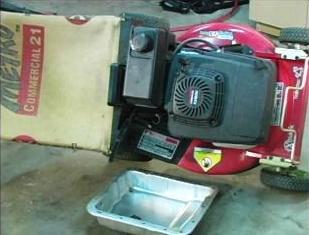Introduction: How to Change Lawn Mower Oil
The small engines that run lawn mowers need their oil changed just like car engines. Most mower engines need their oil changed every 20-50 hours of operation.
A mower's owner's manual will indicate how often to perform oil changes on the mower. At the very least, an oil change should be done annually with other seasonal tune-up maintenance.
This article explains the steps for changing oil in most mowers. Changing mower oil is very simple and can take as little as five minutes.
Step 1: Prepare for the Oil Change
1. Warm up the engine
Warming up the mower engine will speed up the oil change because the oil will flow more freely. It will also be a little easier to get all of the old oil out of the engine.
2. Clean around the oil fill area.
Use an air compressor or a clean towel to clean up around the oil fill area
3. Prepare an oil pan to catch the oil.
You'll need an oil pan or something similar to catch the oil from the mower. Position the pan on the side of the mower towards which you will tip it to drain the oil.
Step 2: Dump the Old Oil
4. Remove the oil fill cap.
5. Tip the lawn mower on its side to drain its oil.
It's a good idea to leave the mower resting on its side for about a minute while all of the old oil drips out.

Step 3: Replace the Oil Filter (if Applicable)
If your lawn mower engine model does not include an oil filter, skip to step Step 10 to complete your oil change.
6. Prepare something to catch the oil.
Unscrewing your mower's oil filter will spill the oil it is holding inside of it.

Find something to catch the oil that is small enough to fit under the filter as you unscrew it.

7. Unscrew the old filter.
The old filter simply unscrews.
8. Coat the seal of the new filter with oil.
The seal of the new oil filter needs to be coated with oil before it is installed.
Using your finger, apply a small coat of motor oil to the outside lip of the new filter. This thin coat of oil will ensure that it seals tightly when you install it.
9. Install the new oil filter.
Screw the new oil filter into place until it touches the plate it seals against. Then, give the filter a firm 1/4 or 1/2 turn to tighten it down.
Step 4: Refill Mower Oil
Check the mower owner's manual for the exact quantity of oil that the mower takes.
Use the mower's dipstick as the final judge on the right oil level. Most mowers take between 2/3 and 3/4 a quart of oil
10. Add engine oil gradually until it is full.

Stop a couple of times as you fill the oil to check its level with the dipstick.
Creeping up on the "full" line like this reduces the chance of overfilling.
11. Replace oil cap.
Your lawn mower oil change is now complete.
ConclusionChanging your lawn mower's oil will help its engine run powerfully and dependably. This and other simple equipment maintenance will greatly extend the life of your tools.
eReplacementParts.com can help you with your lawn & garden machine repairs. Visit our Lawn Mower Parts page to shop for parts by mower brand, or visit our Small Engine Parts page for more small engine maintenance parts.




